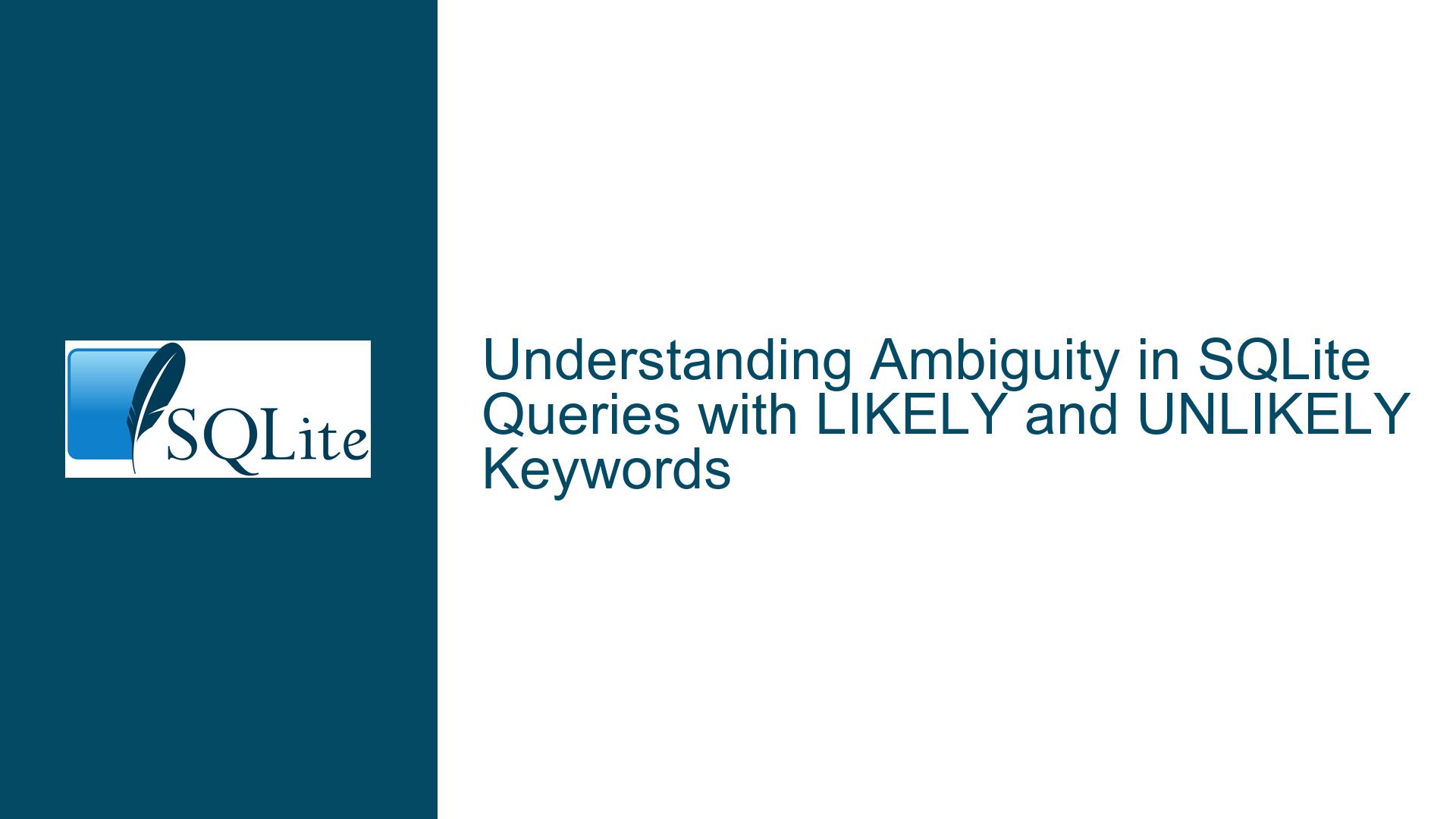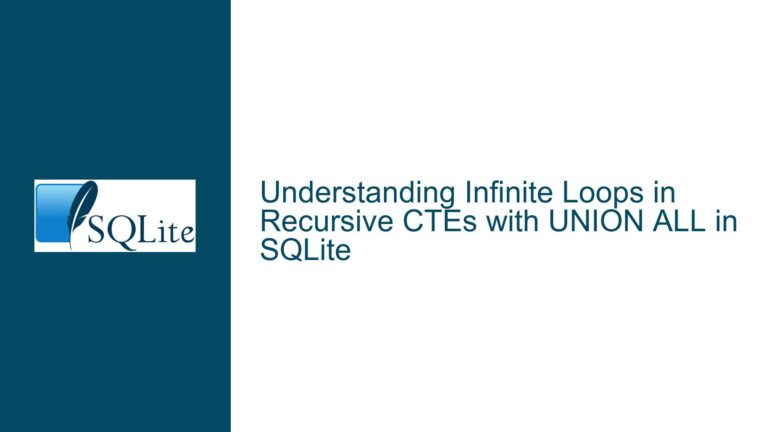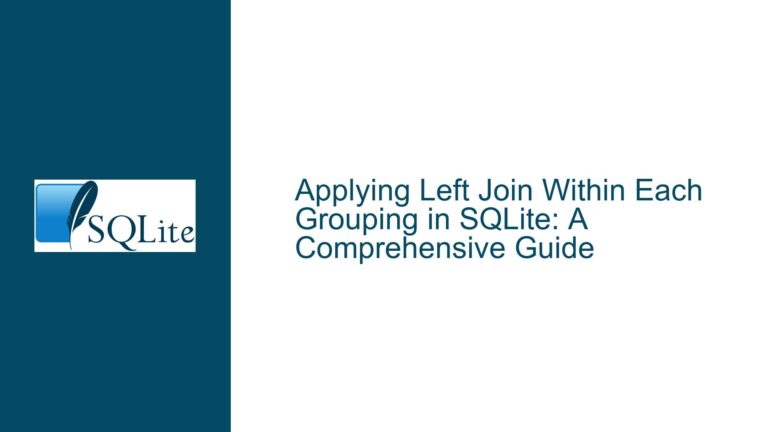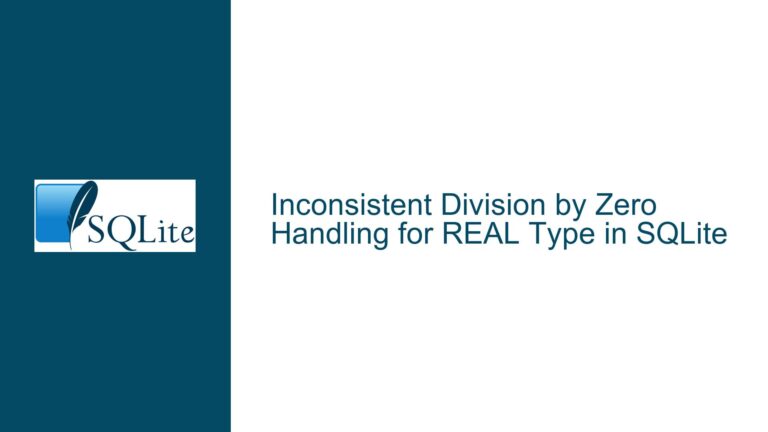Ambiguity in SQLite Queries with LIKELY and UNLIKELY Keywords
Ambiguity in Query Results Due to LIKELY and UNLIKELY Keywords
The core issue revolves around the behavior of SQLite when executing queries that involve the LIKELY and UNLIKELY keywords. These keywords are designed to provide hints to the SQLite query planner about the expected outcome of a condition, which can influence the execution plan chosen by the database engine. However, their use can sometimes lead to ambiguous query results, particularly when dealing with queries that group data or when the data itself contains multiple rows with the same values in the grouped columns.
In the provided example, the table v0 contains columns c1, c2, and c3. The queries in question involve selecting values from c2 while grouping by c3. The results of these queries vary depending on whether the LIKELY or UNLIKELY keywords are used in the WHERE clause. Specifically, the query SELECT c2 FROM v0 WHERE UNLIKELY(c3) GROUP BY c3; returns a different result compared to the query without the UNLIKELY keyword. This discrepancy arises because SQLite is free to choose between multiple valid results when the query is ambiguous, and the use of LIKELY or UNLIKELY can influence this choice.
The ambiguity in the query results is not a bug but rather a consequence of how SQLite handles queries that can have multiple valid outcomes. This behavior is consistent with SQLite’s design philosophy, which prioritizes flexibility and backward compatibility over strict enforcement of query semantics. However, this flexibility can lead to confusion, especially for users who expect more deterministic behavior from their database queries.
Influence of LIKELY and UNLIKELY on Query Execution Plans
The LIKELY and UNLIKELY keywords in SQLite are used to provide hints to the query planner about the expected truth value of a condition. These hints can influence the execution plan chosen by SQLite, potentially leading to different query results when the query is ambiguous. In the context of the example, the condition c3 in the WHERE clause is evaluated differently depending on whether LIKELY or UNLIKELY is used.
When LIKELY(c3) is used, SQLite assumes that the condition is likely to be true, which may lead the query planner to choose an execution plan that optimizes for this assumption. Conversely, when UNLIKELY(c3) is used, SQLite assumes that the condition is unlikely to be true, which may result in a different execution plan. These different execution plans can lead to different results when the query is ambiguous, as SQLite is free to choose between multiple valid outcomes.
The ambiguity in the query results is further compounded by the presence of multiple rows with the same value in the grouped column (c3). In such cases, SQLite may choose any of the valid rows to return, and the use of LIKELY or UNLIKELY can influence this choice. This behavior is consistent with SQLite’s design, which allows for flexibility in query execution but can lead to unexpected results for users who are not aware of the underlying mechanics.
Detecting and Resolving Ambiguity in SQLite Queries
To detect and resolve ambiguity in SQLite queries, users can employ several strategies. One approach is to use the PRAGMA reverse_unordered_selects=ON; setting, which forces SQLite to return results in reverse order. If a query is ambiguous, running it with this pragma enabled will often result in a different outcome, indicating that the query is indeed ambiguous. This technique can be particularly useful for identifying queries that may produce inconsistent results due to the use of LIKELY or UNLIKELY keywords.
Another strategy is to carefully review the data and the query logic to ensure that the query is not inherently ambiguous. For example, in the provided example, the ambiguity arises because there are multiple rows with the same value in the grouped column (c3). By modifying the query to include additional criteria or by restructuring the data, users can often eliminate ambiguity and ensure more deterministic query results.
In cases where ambiguity cannot be eliminated, users may need to accept that SQLite’s behavior is inherently flexible and that the database engine may choose between multiple valid outcomes. This understanding is crucial for users who rely on SQLite for critical applications, as it allows them to design their queries and data structures in a way that minimizes the risk of unexpected results.
Conclusion
The use of LIKELY and UNLIKELY keywords in SQLite can lead to ambiguous query results, particularly when dealing with queries that group data or when the data itself contains multiple rows with the same values in the grouped columns. This behavior is not a bug but rather a consequence of SQLite’s design philosophy, which prioritizes flexibility and backward compatibility. By understanding the influence of these keywords on query execution plans and by employing strategies to detect and resolve ambiguity, users can mitigate the risk of unexpected results and ensure more deterministic query behavior in their SQLite databases.






